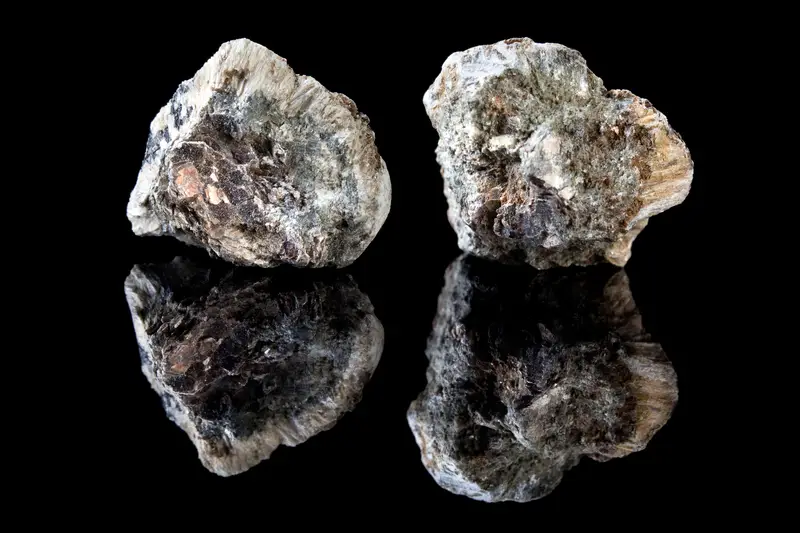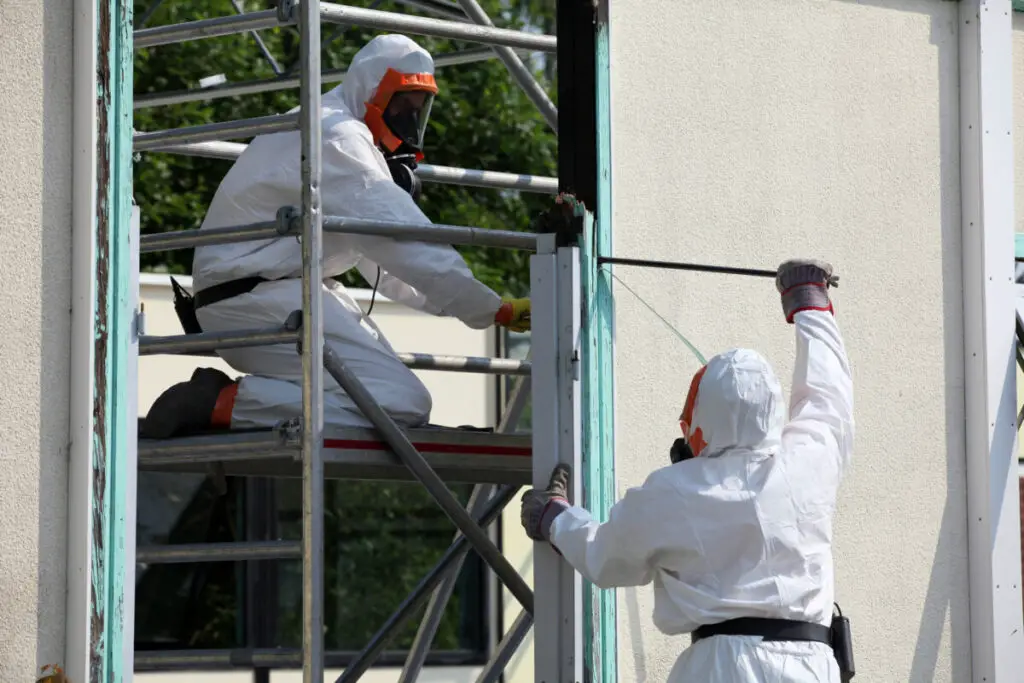Respiratory masks with N100, R100 or P100 NIOSH rating, or 3M negative and positive pressure masks can be used to filter asbestos. Masks fitted with HEPA filter cartridges can also be used for asbestos. However, when manufacturing, processing, or using asbestos-containing products, complete Personal Protective Equipment (PPE) is essential.
Asbestos releases tiny, invisible dust into the air when damaged, and this dust is toxic to our health. A protective respiratory mask is essential for anyone who is at risk of airborne asbestos exposure.
In this article, we talk about asbestos and its health effects. We then discuss the various masks that can provide you with the best protection against asbestos dust. The post also recommends the three best respirators suitable for asbestos exposure.
- Masks fitted with HEPA filter cartridges, or have N100, P100 or R100 NIOSH rated filters are effective against asbestos fibers.
- Full Protective Personal Equipment (PPE) should be worn when using or removing asbestos-containing materials.
- Asbestos fibers are released and become airborne when asbestos-containing material, such as insulation, is damaged. Exposure to asbestos should be avoided.
Risks And Effects Of Asbestos

Asbestos is a naturally occurring, heat-resistant, fibrous mineral.
Its tensile strength and resistance to heat, water and many chemicals resulted in it being widely used in fabric, construction materials, automobile parts, and packaging.
However, when these substances are damaged or mishandled, the asbestos is crushed and releases invisible and tasteless, small fiber dust, measuring 0.1 to 10 microns per particle.
Health Effects Of Airborne Asbestos
While direct skin contact with asbestos (or asbestos-containing products) is toxic, airborne exposure is the primary cause of the health complications associated with the mineral.
Long-term exposure to asbestos dust can lead to the following three major diseases:
- Asbestosis: This is a lung condition characterized by thickening and scarring of the tissue and pleura (protective membrane covering the thoracic cavity). The lungs become stiff and unable to inflate, which causes shortness of breath.
- Mesothelioma: Asbestos exposure is the main risk factor for mesothelioma, which is a cancer of the pleural membrane. It presents with chest pain, difficulty breathing, fatigue, hoarseness in voice, difficulty swallowing, and rapid weight loss.
- Lung Cancer: This is the deadliest malignancy that occurs with severe, progressive, blood-stained, and persistent cough and chest pain.
Other complications of asbestos inhalation include:
- Shortness of breath
- Dry cough
- Chest pain
- Clubbing of hand and food
- Fatigue
The severity of symptoms depends upon the dosage and length.
According to the Occupational Safety and Health Administration (OSHA), 0.1 asbestos fiber per cubic centimeter of air for eight hours is the permissible exposure limit (PEL) for asbestos. However, given that exposure to even small concentrations of fiber dust for a long time can lead to severe chronic diseases, it is best to ensure complete safety against asbestos.
Note that while small amounts of asbestos may be broken down or naturally cleared from the lungs, the dust can collect in the body. It has a 40 years latency period, which means people stay at risk of developing scarring and other complications years after asbestos exposure.
People At High Risk Of Asbestos Exposure
The following groups are at higher risk of asbestos exposure:
- Laborers working in construction trades and building maintenance
- First responders (firefighters, police, paramedics) in disasters like bomb blasts
- People living in areas prone to natural disasters like earthquakes and landslide
Respiratory Masks To Protect Against Asbestos
Respiratory medical masks purify the air you breathe and thus provide an essential protective barrier against airborne contaminants.

For asbestos removal, you need a mask that can filter microscopic particles (at least 0.3 microns or more) with over 99.97% efficiency.
Personal Protective Equipment (or PPE) for asbestos are complete, often disposable, attire consisting of respirators, eyewear, coveralls, rubber boots, and gloves. This is especially essential for anyone involved in manufacturing asbestos-containing products.
Other than high-end PPE kits, there is some respiratory protective equipment that can filter microscopic particles like lead and asbestos dust. N100, R100, and P100 masks offer critical protection by filtering airborne asbestos dust.
Many 3M branded respirators are also capable of filtering asbestos, in particular those that are negative pressure reusable or positive pressure powered.
Here are three of the best respirators for asbestos (All are available on Amazon):
Air Stealth N100 Reusable Respirator Half Mask
The first product is a TREND STEALTH Air Stealth N100 Reusable Respirator Half Mask. It is certified by NIOSH to have a filter efficiency of over 99.97% against non-oil-based particulate matter, which includes asbestos.
It comes with two filters to effectively filter fine particle contaminants.
Since you generally have to wear a mask constantly for asbestos protection, the Air Stealth N100 is particularly focused on comfort. It’s made from polycarbonate and cloth, which are Ideal materials for sensitive skin, and is latex and silicone free.
It also has a lower exhalation valve which helps prevent fogging for people that wear glasses.
3M Aura Particulate Respirator
The 3M Full Face Respirator Kit is fitted with 2097 particulate filters that meet NIOSH’s criteria for a P100 filter.
It has been designed to fit a variety of face cuts and sizes. The full face design has several features including a silicon seal that is surprisingly comfortable, and a large field of view. In fact, the full face lens makes this respirator easier to wear for long periods of time.
3M Half Facepiece Respirator Assembly Kit 6191
Lastly, we have 3M Half Facepiece Respirator Assembly Kit 6191. This is a half-facepiece respirator with a P100 filter that protects not only against asbestos but also arsenic, lead, cadmium, and MDA.
The design ensures easy adjustment and maximum comfort while also providing the perfect seal that prevents airborne contaminants from entering the nose.
Note that the filter is removable and can be replaced with any NIOSH-approved 3M filters and cartridges.
Note that regular disposable masks cannot protect against asbestos.
How Long Should You Wear A Respirator Mask For Asbestos?
Anyone who is prone to asbestos exposure should wear disposable protective gear all the time they are in the exposed area. This is because even small concentrations of asbestos are unsafe and can lead to serious illnesses.
Employers are mandated by law to assess the workplace for possible asbestos contamination. For people in factory setups dealing with asbestos-containing products, it is important to adhere to OSHA safety guidelines on the subject.
Although the Environment Protection Agency (EPA) has now banned asbestos use in construction materials, most old buildings remain at risk of damage and consequent asbestos contamination. In those relevant areas, the authorities concerned with maintenance and repair regularly inspect for asbestos contamination.
Other Ways To Prevent Asbestos Toxicity
Here are some of the other ways to reduce the risk of health complications associated with asbestos exposure:
- When working in a high-risk area, always wear protective gear. Make sure the equipment is clean and working. Remember to dispose of it properly after the shift.
- Do not smoke in the work area. It is also better to avoid drinking and eating when around asbestos products.
- After your shift, clean the work area properly. To reduce the risk of exposure, use a Type H vacuum cleaner and wet rags to clean dust.
- Safely dispose of asbestos waste.
- Get scanned (X-rays) for asbestos accumulation. Although X-rays don’t reveal asbestos accumulation in the body, they can help diagnose onset symptoms of tissue damage and fibrosis. Early diagnosis can help treat and manage the disease, preventing progression to an irreversible form.
- Use an air purifier to help remove asbestos fibers from the air.
Plentiful Air has a complete guide to air purifiers that can remove asbestos available here.
Can You Use An N95 Mask for Asbestos?
N95 masks are ineffective against asbestos, gases, and vapors. These masks should not be used when exposed to asbestos fibers, as they do not provide adequate protection.
Do 3M Masks Protect You From Asbestos?
3M produce several reusable, negative and positive pressure masks, including the 3M 6000 Lead and Asbestos Respirator and 3M asbestos kit 7535, that can be used for protection against asbestos.
Does P100 Protect You From Asbestos?
A P100 filter prevents asbestos, in addition to lead, arsenic, cadmium, and plasma malondialdehyde (MDA) from entering the respiratory system. Masks with P100 filtration can provide effective protection against airborne asbestos fibers.
What Should I Wear To Protect Myself From Asbestos?
When working in an environment with a high risk of asbestos exposure, wearing disposable coveralls, i.e., Personal Protective Equipment (PPE), at all times is essential.



